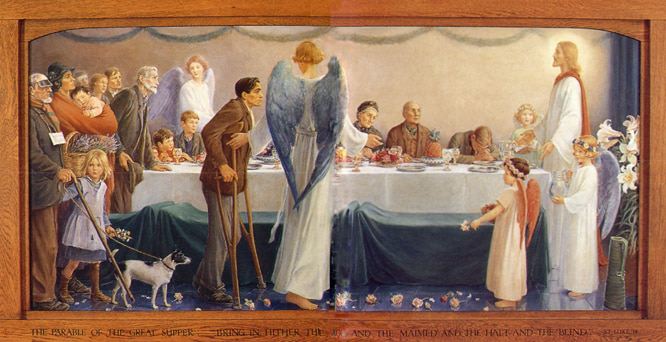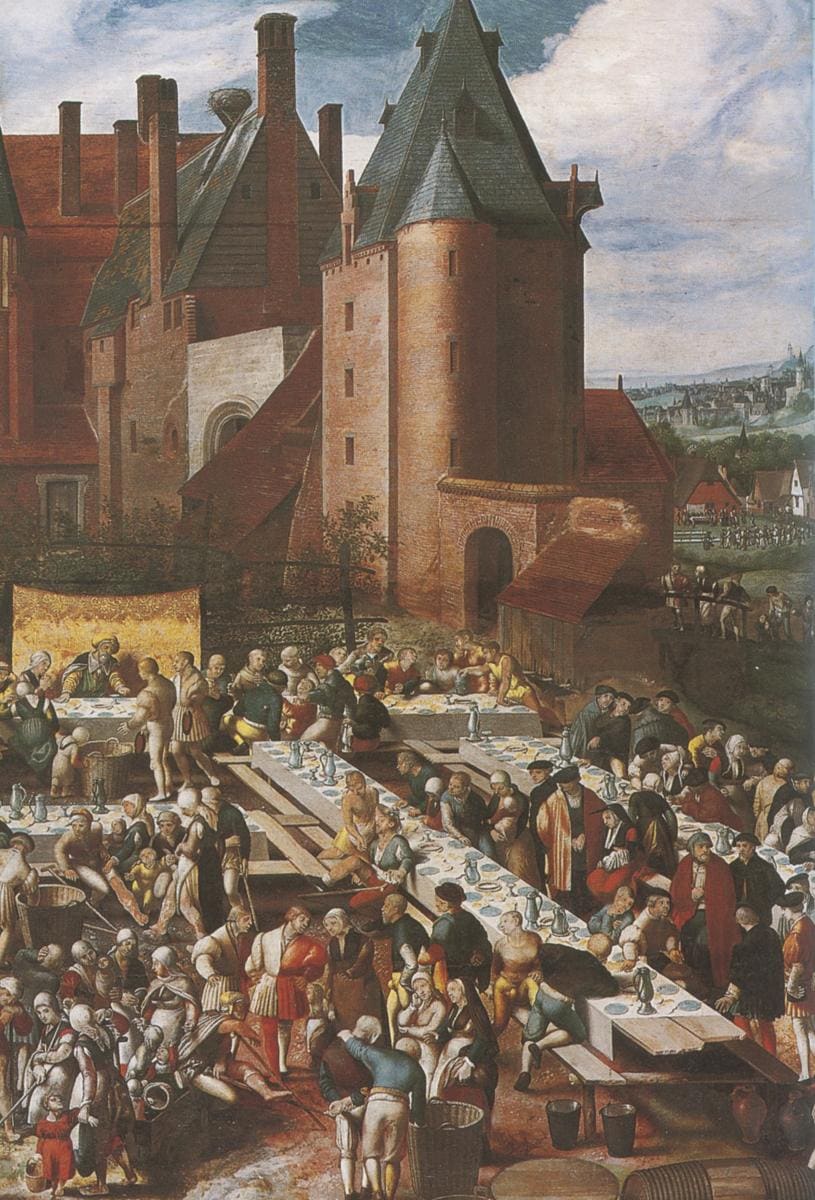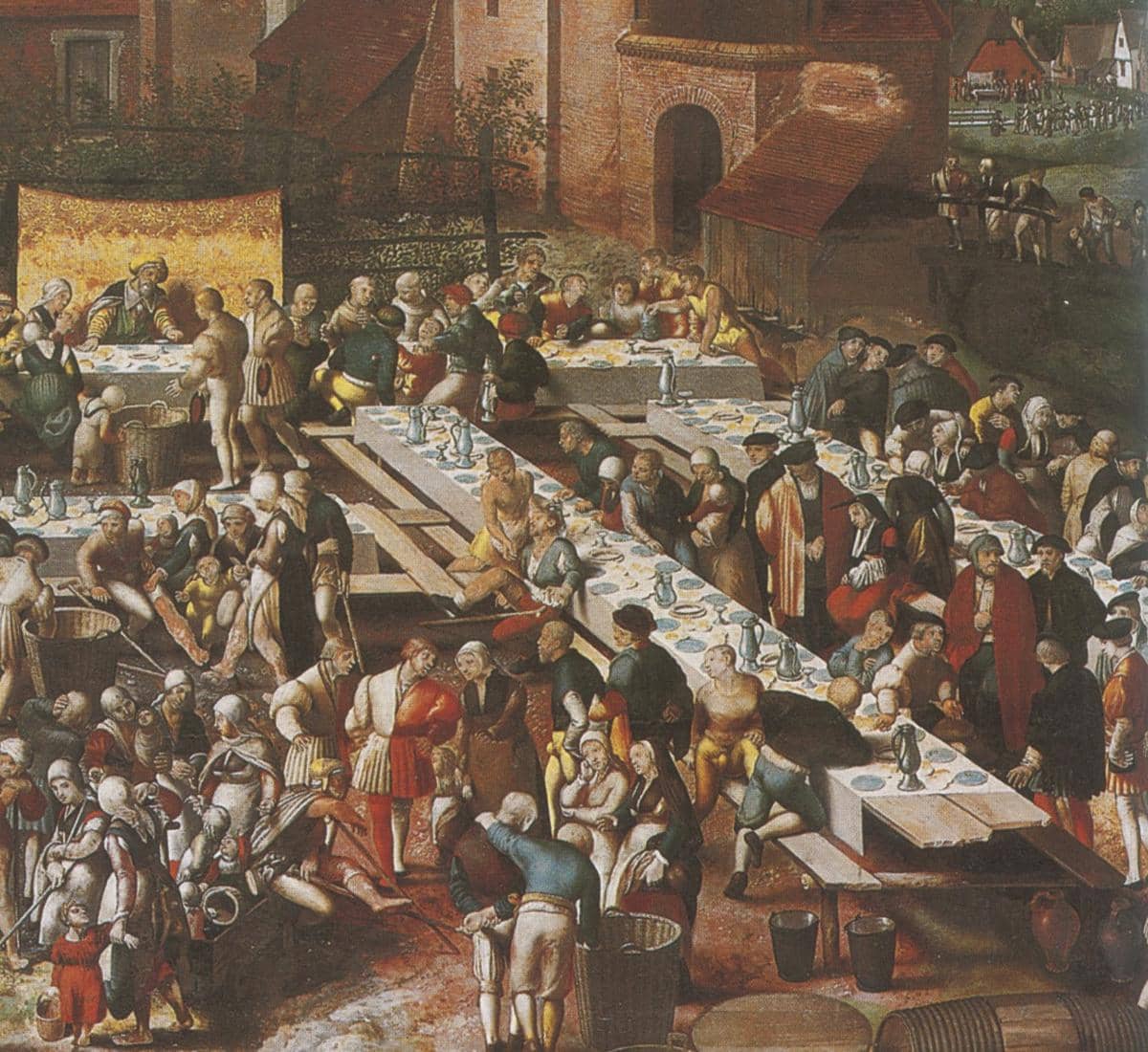March 12: A Parable of the Great Feast
♫ Music:
Saturday, March 12
Scripture: Luke 14:15-24
When one of those who reclined at table with him heard these things, he said to him, “Blessed is everyone who will eat bread in the kingdom of God!” But he said to him, “A man once gave a great banquet and invited many. And at the time for the banquet he sent his servant to say to those who had been invited, ‘Come, for everything is now ready.’ But they all alike began to make excuses. The first said to him, ‘I have bought a field, and I must go out and see it. Please have me excused.’ And another said, ‘I have bought five yoke of oxen, and I go to examine them. Please have me excused.’ And another said, ‘I have married a wife, and therefore I cannot come.’ So the servant came and reported these things to his master. Then the master of the house became angry and said to his servant, ‘Go out quickly to the streets and lanes of the city, and bring in the poor and crippled and blind and lame.’ And the servant said, ‘Sir, what you commanded has been done, and still there is room.’ And the master said to the servant, ‘Go out to the highways and hedges and compel people to come in, that my house may be filled. For I tell you, none of those men who were invited shall taste my banquet.’”
A PARABLE OF THE GREAT FEAST
“‘Blessed is everyone who will eat bread in the kingdom of God!’
But Jesus said to him…”
How easy, it seems, to imagine the great feast of the kingdom of God. We see ourselves reclining at the table, smacking our lips, savoring the bread of the kingdom in good company. How easy, it seems, to forget how little the bread from heaven suited the tastes of Israel in the desert, how very little the self-proclaimed Bread of Life come down from heaven was savored by His own people.
Blessed indeed is everyone who will eat bread in the kingdom, but who wants to eat it? Left only to our tastes, we find ourselves profoundly disinclined when confronted by bread from heaven. But this is hard for us to swallow.
So it is easier to imagine, along with this perhaps pious gentleman in Luke 14—reclining at the table with Jesus, a fellow guest enjoying the Sabbath hospitality of the ruler of the Pharisees—that we are eagerly anticipating the rewards of the righteous.
But Jesus confronts the man and us with His own vision of feasting in God’s kingdom, and so re-frames the question: but who is it who will eat bread in the kingdom of God?
The two paintings for today’s devotional offer starkly alternative images of this great banquet. Cicely Mary Barker’s triptych The Parable of the Great Supper envisions an intimate encounter with Jesus, Master of the Feast. In a small dining room, laurel garlands grace the wall, roses adorn the table and floor, a damask cloth and sparkling goblets welcome the guests to the table whose places are still being filled. The triptych was made for a newly built church in a government-subsidized housing project near Croyden, where Barker was one of the first Sunday school teachers for a time. She featured faces known in this needy community, including her own elderly mother seated at the table. In that sense, the triptych is a mirror that offers to transform those who can find in it someone like themselves welcomed richly by Jesus. Barker also includes a gypsy woman and her child, a wayfarer who could have attracted distrust. Still, however much the gypsy woman might have posed a challenge to the congregation, the figures in the painting are not bothered by her at all. Nearly all eyes are intently gazing with trust at Jesus as they are welcomed and guided to their seats by angels. All but two: a little girl glances uncertainly outward, as if worried that she is out of place, and the young man opposite her and closest to Jesus bows his head, eyes closed over clasped hands. Together, these two figures frame the intimate welcome with a note of awed humility, which reminds us that such welcomes are not at all what the world teaches us to expect for these guests. And in that reminder lies a rebuke, for it is precisely for these guests that such a welcome is fitting, because they actually want it.
Barker gives us here an image of hunger met with satisfaction, need adorned by grace, humility encountering glory. She focuses mainly on the second set of invited guests from the parable, those who were found in the city streets: the poor, the crippled, the lame, the blind. Though they mostly crowd the left-hand side of the image, some lean forward, giving an impression of both a sense of security and of anticipation. Love already binds some together—the mother and child, the girl and the blind man, the two young boys already seated, one with his arm around the other—and love also drives all towards the table, towards the feast, towards Christ. Barker’s image helps me delight in the unexpected guest list because I love the satisfaction of their very real hunger for precisely what Jesus is offering.
But when I turn to Jan Van Amstel’s The Parable of the Marriage Feast and his vision of “everyone who will eat bread in the kingdom of God”, I find myself jarred and unsettled by the motley assortment there. Like Barker, Van Amstel paints a feast whose places are not yet filled, but he does so by leaving neglected tables with empty seats and by punctuating the tables’ orderly procession with lively crowds and clusters of figures with a wide variety of gestures, facial expressions, and postures. In Barker’s work, there was near unity of expression; here in Van Amstel’s you find people who are hopeful, eager, ill, distracted, irritated, suspicious, indecorous, ungainly, scolding, angry, ashamed, alone. One woman is even footing her way across the top of the Master’s own table to a rather eager-looking man, while another man nearby seems to be sneaking more drink than he should. Almost none are attending to the Master of the feast in front of the golden curtain.
Van Amstel also presents the rivals to the Master’s feast. In the remote background in the upper left, two sets of tiny figures point to cattle or an empty field, their visual diminishment and isolation revealing a petty self-involvement. But where is the third, the newly married man? He stands near the village on the right, also dwarfed in size like the others, but this time pointing to an alternative feast—his own wedding, above and slightly left of him, drawing its own guests through a near-by gate. A tidy circle of dancers revel together near the gate, while an orderly line of guests greet the bride who, like the Master of the feast, appears in front of a light-colored rectangular curtain.
Van Amstel clearly stages a choice between these two feasts, and I am far more drawn to the tame wedding, with its apparently well-behaved and respectable guests. Van Amstel stretches, even strains our imagination of God’s radical hospitality, and that confronts me with my own perverted taste for mere respectability. But unlike Barker, Van Amstel fails to link that hospitality to what we really hunger for. He leaves the Master’s guests unsatisfied, unadorned, and ultimately unencountered. In portraying the guests as largely indifferent to the Master of the feast, Van Amstel fails to show us what we really need to see from the parable: that the house of the Master will indeed be filled, and filled by grace, but only with those hungry for what He alone provides.
God’s hospitality is far greater than we can imagine. He will fill His house with guests. The petty disinclination of some will not be able to spoil His party; rather, their disinterest serves to make even more brilliant the glory of His generosity. Extend the invitation past the unresponsive insiders to outsiders, yea, to wayfarers, and urge them to come in! God gives beyond the table we can imagine, bounding towards the unexpectant and unworthy with an unstoppable exuberant grace. For whether we know it or not, we are none of us insiders. We are all unfit, ungainly, unworthy, all guilty, all hungry, all poor. Our need, too, is more urgent than we can imagine, and we all need to come now, for now is the time of the call. The Feast is ready.
Come to the Feast.
To delay is to admit that you do not desire.
Come to the Feast.
Ignore your tastes, and mind your hunger.
Come to the Feast.
PRAYER
Lord of unimaginable hospitality,
Teach us to ignore our petty tastes
And attend instead to our deepest hunger,
Satisfied only with the bread of Your kingdom.
Amen.
Diane Vincent, Associate Professor of Medieval Literature, Torrey Honors Institute
Artwork #1
The Parable of the Great Supper
Cicely Mary Barker
Oil on canvas
St. George’s Church, London, England
A magnifiable high resolution image and some detailed close-ups of Barker’s work can be seen on this Flickr feed https://www.flickr.com/photos/32445100@N03/7448574626
About the Artist and Art #1
Cicely Mary Barker (1895-1973) was an English illustrator best known for a series of fantasy watercolors depicting fairies and flowers. Her earliest professional work included greeting cards and magazine illustrations. Barker, a devout Christian, donated many of her artworks to Christian fundraisers and missionary organizations. She produced Christian themed books including The Children’s Book of Hymns and He Leadeth Me. She designed a stained glass window for St. Edmund's Church, Pitlake, and her painting of the Christ Child, The Darling of the World Has Come, was purchased by Queen Mary. The Parable of the Great Supper was commissioned and hangs in St. George’s Lady Chapel in London. The central panel of this triptych (shown) depicts Jesus’ parable from Luke 14. Fine arts conservator, Helen De Borchgrave writes, “The motley crowd whom Jesus welcomes with open hands to his supper, was probably instantly recognized to members of the congregation. Cicely’s own mother has already been settled in her place by an adult angel. The gypsy woman with her basket of lavender and baby clasped to her bosom, the blind match-seller led by a little girl and by Cicely’s own dog, the young man on crutches, possibly crippled in the First World War, wait with others to be seated. Everyone looks to Jesus with joyful recognition, loving trust, and hopeful expectation.”
Artwork #2
The Parable of the Marriage Feast
Jan van Amstel
Oil on canvas
A magnifiable, high resolution image of Van Amstel’s work can be viewed at http://www.3landesmuseen.de/Niederlaendische-Malerei-16-Jahrhundert.642.0.html.
About the Artist and Art #2
There is little known about artist Jan van Amstel (1500-1542) who was a Dutch Northern Renaissance painter. He joined the Guild of Saint Luke in 1528 when he moved to Antwerp. He was evidently praised as a gifted landscape painter although a number of his scenes, including The Parable of the Marriage Feast are filled with numerous figures. In this painting, the viewer gets a real feel for the scale and scope of the Master’s request to “Go out into the highways and hedges and compel them to come in.”
About the Music
“Come to the Feast”
Lyrics
Go to the highways and hedges,
Go to the furthest of fields,
Go and compel the sick and the well
For our Father’s house will be filled.
Go to the streets of the city,
Bring in the crippled and blind.
All who would taste this banquet of grace,
Must come and waste no more time.
In the robe of the Lamb you’ll be covered:
Dressed in His pure righteousness.
For all of your guilt His blood it was spilt,
So come, by your Father be blessed.
Come to the feast, come to the table,
The great and the least, the right and the poor.
Come to the feast, come to the table,
Oh come and hunger no more.
About the Musicians
The Gospel Coalition is a network of evangelical churches founded in 2005. They have regional events and chapters across the USA and a directory of almost 8,000 affiliated churches across the world. In 2013, TGC released Songs for the Book of Luke, an album written and performed by various artists from their USA churches. “Come to the Feast” was written by Jeff Lawson, the worship arts director at Vintage Ten in St. Louis, Missouri. “The lyrics celebrate God’s great grace, which makes room for ‘the sick and the well,’ ‘the crippled and blind,’ and for all of us--not because we’re worthy, but because of Christ’s sacrifice.”
www.thegospelcoalition.org/lukealbum


